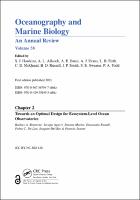Chapter 2 Towards an Optimal Design for Ecosystem-Level Ocean Observatories
Proposal review
Author(s)
Rountree, Rodney A.
Aguzzi, Jacopo
Marini, Simone
Fanelli, Emanuela
De Leo, Fabio C.
Del Rio, Joaquin
Juanes, Francis
Language
English[eng]Abstract
Four operational factors, together with high development cost, currently limit the use of ocean observatories in ecological and fisheries applications: 1) limited spatial coverage; 2) limited integration of multiple types of technologies; 3) limitations in the experimental design for in situ studies; and 4) potential unpredicted bias in monitoring outcomes due to the infrastructure’s presence and functioning footprint. To address these limitations, we propose a novel concept of a standardized “ecosystem observatory module” structure composed of a central node and three tethered satellite pods together with permanent mobile platforms. The module would be designed with a rigid spatial configuration to optimize overlap among multiple observation technologies each providing 360° coverage of a cylindrical or hemi-spherical volume around the module, including permanent stereo-video cameras, acoustic imaging sonar cameras, horizontal multi-beam echosounders and a passive acoustic array. The incorporation of multiple integrated observation technologies would enable unprecedented quantification of macrofaunal composition, abundance and density surrounding the module, as well as the ability to track the movements of individual fishes and macroinvertebrates. Such a standardized modular design would allow for the hierarchical spatial connection of observatory modules into local module clusters and larger geographic module networks, providing synoptic data within and across linked ecosystems suitable for fisheries and ecosystem level monitoring on multiple scales.
Keywords
Volume, Todd, Swearer, Smith, S, Russell, Review, P, OMBAR, Oceanography, Marine, L, I, Hawkins, Firth, Evans, Biology, Bates,B, Annual, AllcockISBN
9780367367947, 9780429351495, 9780367524722Publisher
Taylor & FrancisPublisher website
https://taylorandfrancis.com/Publication date and place
2020Imprint
CRC PressClassification
Marine biology


 Download
Download